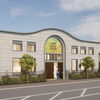Up and away | Bangor International Airport has gone from sputtering turboprops to record traffic, but must stay alert to stay on top
Even though NASA has never had to use an emergency landing site and didn't do so this time either, the decision was one of several signs that BIA is on the national radar, according to BIA Director Rebecca Hupp. But more relevant to the day-to-day functioning and long-term financial prospects of the airport are the passengers and carriers that use BIA throughout the year, she says. And passenger traffic is where BIA has been getting considerably more press lately.
As it stands now, the airport is on track to have a record year, according to Hupp. Passenger boarding was up more than 11% in July ˆ the most recent month for which figures are available ˆ making it the best July since the airport began tracking passenger traffic 10 years ago, Hupp says.
More importantly, with 276,000 passengers having gone through the airport and boardings up six percent over 2004 figures by the end of July, and late-year holidays still to come, the airport could shatter its one-year record this year. "We had 452,000 passengers last year, and the best year prior to that was 1998 with 456,000," Hupp says. "At the rate we're going now, we can confidently say that we are likely to exceed 1998's numbers and perhaps exceed 500,000 passengers."
In addition, the Boyd Group, an aviation consulting and forecasting company, recently predicted that BIA will have the fastest growth of any U.S. airport over the next five years. The Colorado-based company studies airports across the nation, generating weekly and monthly assessments in addition to the five-year growth projection it released earlier this year. For the five-year report, the Boyd Group examined 133 airports, encompassing 95% of U.S. passenger boardings. BIA is expected to increase its passenger base by nearly 32%, edging out Boston's Logan International Airport for the top growth spot. Others in the top 10 include airports in Atlanta, Phoenix and Milwaukee.
Airline numbers seem to support that analysis: Continental Express has seen a 410% increase over last year in passenger traffic at BIA, resulting from its service to Newark, N.J., Hupp told the Bangor Daily News recently. The paper also reported that U.S. Airways has seen a 54% increase over last year in passenger boarding.
Although some might argue that Bangor simply benefits from starting off with a smaller base of passengers and thus having more noticeable increases ˆ Logan counted 26 million passengers last year compared to BIA's 452,000 ˆ the Boyd Group thinks something more is at work. Michael Boyd, president of the group, has cited rising demand for regional hubs and BIA's aggressive pursuit of new markets, as well as economic stability in the Bangor area, as reasons for the airport's presence at the top of the list.
Hupp cites the very same factors for her airport's growth, adding that the attraction of Maine as a tourism destination also helps. In addition, increased capacity and competition among airlines ˆ something BIA worked years to establish ˆ contribute to the airport's growth. "We have more jet capacity available in our market today than we ever have before," she says. "That means more destinations, more carriers, more competition, more frequent flights and better fares ˆ the kinds of things you need to convince people to fly through their local airport rather than go to New Hampshire or Boston."
But with growth also comes growing pains. As Hupp notes, the airport is outgrowing its parking capacity and might need other infrastructure work in the coming years, such as additional jet bridges, to keep up with demand and continue to be attractive to airlines and passengers.
Sprucing up the place
First on the list of concerns for the airport to manage its growth well is making sure passengers have places to park, say Hupp and Bangor City Manager Ed Barrett. "If people cannot park their cars, they aren't going to want to come here to fly," says Barrett, who has a vested interest in the airport's success, since the city owns and operates BIA.
BIA is still early in the process of expanding its parking, and is getting ready to delve into design contract relationships, according to Hupp. "The footprint for the garage would be within the bounds of our existing parking lot, so we haven't encountered any kind of resistance in terms of whether we should build it where we plan to," she says. "In fact, people are pretty favorable toward the idea. In addition to more spaces, people want covered parking."
The garage is projected to cost more than $7 million, which would be paid for through parking fees. Plans currently call for a multi-level structure that would have space for up to 500 vehicles, including rental cars. The garage is expected to replace about 150 open-air spaces within the same footprint, Hupp says. By the time all is said and done, she says, the airport could have a total of 800 spaces between covered and open-air options. (By way of comparison, Portland International Jetport has nearly 1,500 spaces in its parking garage, with long-terms plans to expand to as many as 5,000.)
But it's not all about parking cars, Hupp notes. Also of concern as the airport's traffic increases and the number of carriers and destinations possibly expands is the number of jet bridges available to get people on and off the regional jets that now make up virtually all of BIA's traffic.
According to Bob Ziegelaar, president of Telford Aviation Services in Bangor, one of the most significant changes in the aviation industry in the past 10 years has been the advent of 35- to 100-seat regional jets, which replaced larger jets and "right-sized" the airplanes to passengers' needs, especially in smaller airports. As airlines have increased their business at BIA since the late 1990s, it has been regional jets that are dotting the tarmac rather than the turboprop planes that were the norm after the 747s, 727s and other large jets of United and Delta left BIA in the 1990s. "A sizable portion of the flying public is really not happy with the idea of flying in turboprops," Barrett says, "and that certainly didn't help us attract people to fly through BIA."
The turboprops began to disappear in 2001, and currently the airport hosts 100% regional jets for commercial flights, though other types of planes sometimes come and go for chartered or private flights.
But while Barrett, Hupp and Ziegelaar all note that regional jets have made it feasible for airlines to run significant traffic through the airport and make flying more comfortable for passengers, the shift does raise concerns about whether there are enough jet bridges to go around.
"Now that we've gone from one carrier to four carriers utilizing jet bridges, some of them are shared," Hupp explains. "As capacity increases, and as additional carriers are brought in, we could need more jet bridges. However, it could also be that some of the bridges we have at the international terminal are underutilized, so we have to look into that."
To examine this and other issues ˆ such as security, compliance with the Americans with Disabilities Act and the question of whether restrooms can be added beyond the security checkpoint ˆ the airport will soon begin a study of its operations to determine what works, what needs to change and what kind of construction will be needed to alter existing facilities or expand them, Hupp says.
Maintaining altitude
Despite the Boyd Group's confidence that BIA will continue to grow, Barrett, Hupp and Ziegelaar all have lingering concerns.
According to Ziegelaar, who was Hupp's predecessor at BIA before he moved to Telford, the airline industry has been "in turmoil" for the past 30 years, and that turmoil could increase, particularly with fuel prices skyrocketing and several carriers recently filing for bankruptcy. That, in turn, could cause carriers to reduce service to BIA or leave the airport entirely.
Even during a decades-long period of turmoil, many airlines and the communities in which they flew had been willing until recent years to build airline capacity without a clearly defined need, Ziegelaar says, but no more. "In the past, there was a lot of thinking that if you could only direct the air traffic, you could make a community grow," he notes. "So, when big jets pulled out of Bangor, people thought that was the end of our opportunities. In reality, it's the size of the market and the economic characteristics of the market that determine what kind of service you get. You will no longer find airline companies that will say, let's build it and see if they will come."
Barrett, Hupp and others in Bangor's government and business community have been keenly aware of this trend for some time, and just because they drew airlines back to the city doesn't mean they assume those airlines will stay. "Airline growth doesn't just happen," Hupp says. "We actually work behind the scenes with existing and potential carriers all the time to make presentations about what we think are good business opportunities for them. We're not sitting back waiting for airlines to come to us. We talk to them about we can do and what they can get from being here, and that's critical to our past, current and future growth."
For example, BIA officials are in talks with one airline to add non-stop service to Washington, D.C. The business hook for the airline ˆ which also happens to be the added value that BIA is looking for ˆ is increased access to international markets and international travelers.
Barrett and Hupp say that marketing the airport to the public through advertising campaigns and outreach to community groups has been important for increasing business and will continue to be important in the future. Hupp acknowledges that international flights through BIA currently are sporadic at best ˆ and what flights there are tend to be charters or military transports ˆ and she and Barrett see Canadian airlines as a possible way to fill that gap.
Even though Hupp cites the importance of Maine as an attractive tourism destination, neither she nor Barrett relies on tourist visits as a major revenue stream, since they say the majority of the airport's income comes from people in Maine, particularly those who live within easy driving distance of Bangor ˆ which includes Maine communities as far out as Ellsworth, Lincoln, Belfast, Skowhegan and Camden-Rockland, as well as western New Brunswick in Canada. To that end, Barrett is interested in exploring how to get more low-cost flights to and from Florida at Bangor, so that the airport can compete with Manchester, N.H.
As for capacity for future growth, Hupp says the airport has all the room it needs for the foreseeable future to expand and meet the needs of customers in the region. But it will be the community that drives airport growth, she said, not BIA itself.
Ziegelaar agrees. "I'm optimistic about the airport's prospects for continued growth but also confident that it will never outpace the growth of the community," he says. "Some people have made the mistake of thinking that if you just build in the air service, their community will grow accordingly. But it's really the other way around, and the administrators at Bangor International are very aware of that fact."









Comments